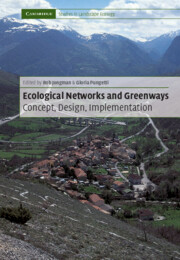Book contents
- Frontmatter
- Contents
- List of contributors
- Foreword
- Preface
- Acknowledgements
- 1 Introduction: ecological networks and greenways
- 2 The context and concept of ecological networks
- 3 Greenways in the USA: theory, trends and prospects
- 4 Ecological functioning of ecological networks: a species perspective
- 5 Impacts of roads on ecological networks and integration of conservation and transportation planning: Florida as a case study
- 6 Ecological corridors on a European scale: a typology and identification of target species
- 7 Planning the future landscape between nature and culture
- 8 From models to reality: design and implementation process
- 9 Design of the Pan-European Ecological Network: a national level attempt
- 10 Ecological ‘black spots’ within the ecological network: an improved design for rural road network amelioration
- 11 An ecological network for the Milan region based on focal species
- 12 Connecting corridors: implementing metropolitan greenway networks in North America
- 13 The Florida Statewide Greenways Project: its realisation and political context
- 14 The ecological network development in the Yungas, Argentina: planning, economic and social aspects
- 15 The river corridor of the Guadiamar
- 16 Conclusions: into the twenty-first century
- References
- Index
7 - Planning the future landscape between nature and culture
Published online by Cambridge University Press: 29 December 2009
- Frontmatter
- Contents
- List of contributors
- Foreword
- Preface
- Acknowledgements
- 1 Introduction: ecological networks and greenways
- 2 The context and concept of ecological networks
- 3 Greenways in the USA: theory, trends and prospects
- 4 Ecological functioning of ecological networks: a species perspective
- 5 Impacts of roads on ecological networks and integration of conservation and transportation planning: Florida as a case study
- 6 Ecological corridors on a European scale: a typology and identification of target species
- 7 Planning the future landscape between nature and culture
- 8 From models to reality: design and implementation process
- 9 Design of the Pan-European Ecological Network: a national level attempt
- 10 Ecological ‘black spots’ within the ecological network: an improved design for rural road network amelioration
- 11 An ecological network for the Milan region based on focal species
- 12 Connecting corridors: implementing metropolitan greenway networks in North America
- 13 The Florida Statewide Greenways Project: its realisation and political context
- 14 The ecological network development in the Yungas, Argentina: planning, economic and social aspects
- 15 The river corridor of the Guadiamar
- 16 Conclusions: into the twenty-first century
- References
- Index
Summary
Introduction
The concept of ecological networks stands within the discourse of nature conservation and land use planning. The rapid changes brought by human activities to the landscape have caused fragmentation of the natural environment and isolation of species and habitats. The degradation and even destruction of these natural habitats are nowadays a common issue (see Bennett 1999) and open up the debate on biodiversity and landscape conservation, natural resources consumption and sustainable development.
Recent studies, however, have indicated how ecological networks in Europe are related to biogeography, population dynamics, landscape ecology and land use science (Jongman 1995, 1998a; Pungetti 1999). There is indeed strong evidence that they do not consist only of ecological elements, but also of cultural components. Nature and culture become thus a key duality in the approach to nature conservation and sustainable development for the new millennium.
In Italy nature and culture retain their own particular value and weight, are both fundamental in environmental sciences, but are often in conflict. In past traditional practices there was a balance between nature and culture (Pungetti 1995, 1996), but when land use activity declined nature expanded, with several consequences. Ecosystem re-establishment, for instance, often took place with a reduction in biological and landscape diversity, and although there was ecological improvement in rural areas, the cultural landscape vanished.
For the development of ecological networks in areas of cultural landscape (see Kubes 1996) the above aspects become imperative (Figure 7.1). In these areas the link between natural habitats and human practices is quite evident.
- Type
- Chapter
- Information
- Ecological Networks and GreenwaysConcept, Design, Implementation, pp. 107 - 127Publisher: Cambridge University PressPrint publication year: 2004
- 7
- Cited by



